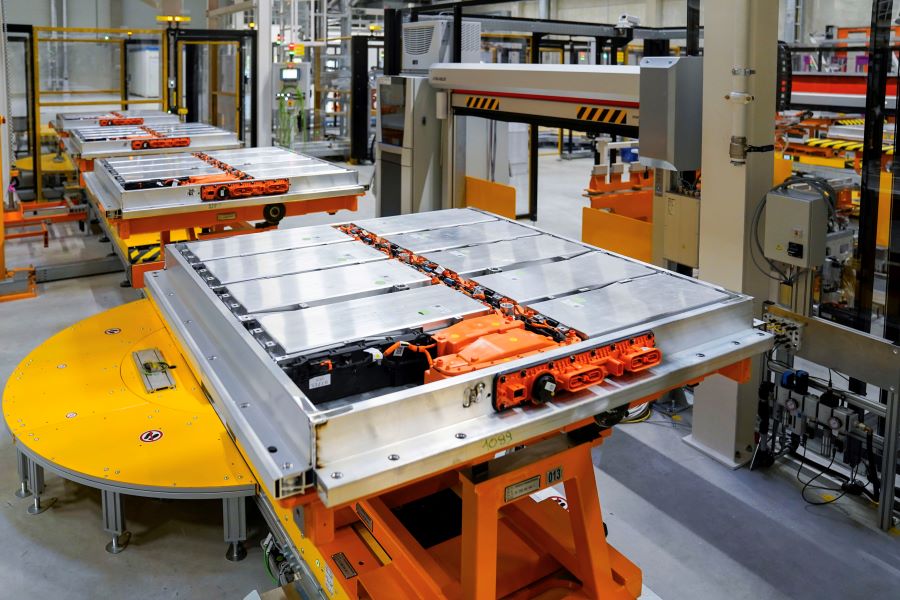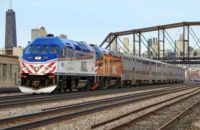Airports around the world depend on many types of ground support equipment (GSE), including baggage carts, deicers, loaders, refuelers, passenger stairs, shuttle buses, tractors and tuggers. To reduce emissions, airlines and airport operators are investing in battery-powered vehicles.
Ground support equipment (GSE) threaded through tightly integrated airport ecosystems are the unsung yet indispensable workhorses of modern travel, ensuring the seamless orchestration of arrivals and departures.
As lifelines of ground operations, these vehicles contribute directly to the punctuality and reliability of flight schedules, shuttling goods, passengers, fuel and baggage, along with performing a host of related functions.
The term GSE encompasses an array of specialized vehicles— from luggage and passenger handling and aircraft maintenance to passenger boarding and deicers— all which play a pivotal role in the aviation industry by providing essential services on the ground.
Today, the ecosystem of GSE vehicles is undergoing a transformative evolution, driven not only by technological innovations but by the industry's commitment to sustainability—not to mention the additional pressure from federal government regulations mandating lower emissions.
The most prominent trend reshaping the GSE sector is the electrification of vehicles. With a growing emphasis on reducing the aviation industry's carbon footprint, electric GSEs are fast gaining traction.
These eco-friendly alternatives not only decrease the carbon footprint of the airline industry, but are forging a greener future across aviation ground operations, while helping keep maintenance costs under control.
Electric motors are appealing, because they’re simple, with just a few moving parts, making them much easier to operate and maintain than traditional gas- or diesel-powered engines.
"If you compare an electric motor with an internal combustion engine (ICE), there are many things that can go wrong with the latter,” says Arturo Garcia, chief operating officer at Avports, a third-party commercial airport manager and operator.
“Much more maintenance is needed,” explains Garcia. “Even if the cost of replacement remains higher on electric vehicles, the number of moving parts and things that can go wrong is much lower in an electric GSE."
ICEs Go Electric
Whether large or small, all airports require a diverse array of vehicles to keep operations running smoothly.
"You have vehicles of all sizes and use cases, and all sorts of operating functions,” says Garcia. “And, it is a pretty unique environment for many different vehicles. Up until recently, they were all powered by internal combustion engines."
The first GSEs to go electric were small baggage tugs, due to air quality concerns for workers inside airport buildings.
"Emissions in an enclosed space are very dangerous," explains Garcia. "That's why baggage tugs were the first GSEs to be electrified."
Today, the No. 1 driver for the evolution to electric GSEs is the shift toward sustainability and the goal of reducing the carbon footprint of airports and airlines.
"It really makes sense to replace those gas-powered vehicles with zero-emission, low-emission options," claims Garcia. "It's the perfect situation right now to continue to make a big push into the transition to zero-emission vehicles for all areas of an airport."
At Westchester County Airport in White Plains, NY, where Avports manages most of the GSEs in operation, more than 40 percent of the vehicles have already gone electric.
"We have plans to substantially increase that percentage over the next few years," says Garcia. "We are currently developing a road map for the next 10 years, ensuring there is an option on the horizon for the life cycle of every single vehicle."
Smaller, lighter vehicles like baggage tugs were the first to go electric, because they have an overall lower cost and they usually weigh less than other GSEs. As a result, they require less power to move and have faster charging cycles.
"We start with the vehicles that are smaller and where the power requirements allow for a charging cycle to be fast in order to keep that utilization rate high," explains Garcia.
As battery technology improves and as the price of the technology falls, Garcia predicts that larger and heavier vehicles will also adopt electric power trains.
"In the past, it was more difficult, because we needed very big batteries and a lot of time to charge those batteries," says Garcia.
"We've been making electric vehicles for some time now, but there is definitely a push to get all our big models and products electrified," adds Amit Ghugari, vice president of global operations at JBT AeroTech, which was recently acquired by Oshkosh Corp. The company makes Commander and Ranger cargo loaders, Tempest deicers and Lektro tractors, as well as the AmpCart mobile charging station.
"[We offer electric versions of many products] and our towbarless tractor is actually only available as an electric vehicle," says Ghugari. "We also offer our customers [different types] of battery options.”
JBT Aerotech offers both lead acid and a variety of lithium-ion batteries, depending on the needs of the customer. The lead acid batteries are procured domestically, while the lithium-ion devices are sourced from Chinese manufacturers.
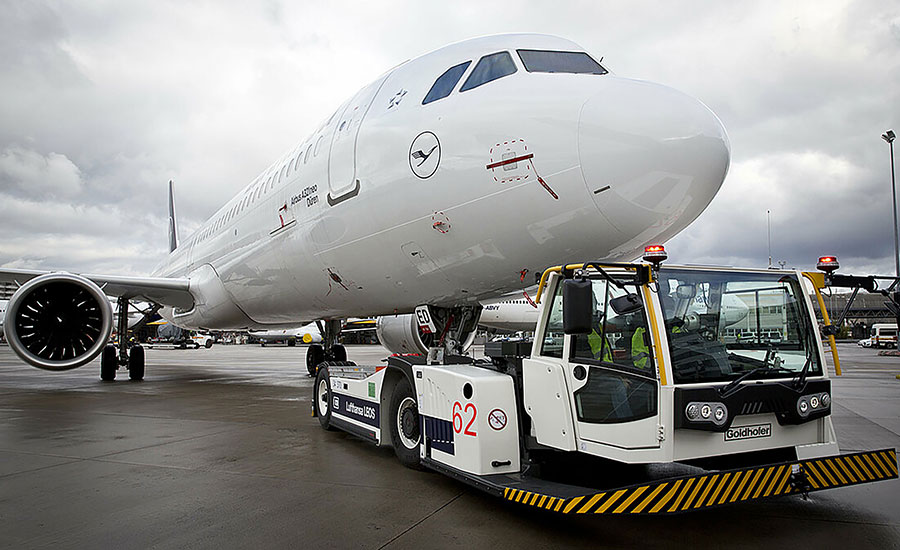
Tuggers and other types of ground support equipment contribute directly to the punctuality and reliability of flight schedules. Photo courtesy Lufthansa
Inspiration Guides GSE Assembly
The assembly process for JBT AeroTech's line of GSEs takes inspiration from automakers such as Ford and Toyota, as well as Six Sigma methodologies to define, measure, analyze and improve processes.
Many of its vehicles are assembled at a state-of-the-art facility in Orlando, FL. The company also has a major manufacturing presence in England and concentrates its electric tractor vehicle manufacturing for the Lektro product line, built for general aviation and the commercial airline industry, on the West Coast.
"Sometimes, customers buy their own batteries and install them, which means we then simply have the equipment ready with the proper testing completed so they can put their batteries in the vehicles," explains Ghugari.
However, because the company's designs are modular, they don't require two different processes when it comes to assembly of diesel vs. electric. All assembly processes are based around a low-volume, high-mix flow line with subassembly stations.
"There are definitely differences, but as far as our assembly goes, we have the same team members trained on a diesel and an electric drivetrain, so on the same line you can see both the diesel and the electric vehicles flowing [simultaneously],” Ghugari points out. "If there is an electric unit that comes in, it flows exactly the same.”
"The complexity of having an electric assembly vs. a diesel is somewhat similar," notes Ghugari. "There are probably an equal number of components and the components change. For example, in an electric vehicle, you have more wiring harnesses and electrical work.
"Through our continuous improvement cycle, we constantly look at places where we determine the best place to apply either lean or Six Sigma principles and the best place to apply automation," says Ghugari. "Because we are not a high-volume environment, most of our automation goes in the upstream processes, which include fabrication, paint and delivery of material to the line."
Harlan Global Manufacturing LLC produces baggage and cargo tractors, push tractors and other types of GSEs at a factory in Kansas City, KS. It also offers an 80-volt electric model called the HLE. Some of the company’s products are based on core designs that are 50 years old, but continuously redesigned and reconfigured.
"We have everything in 3D CAD modeling, and from the 3D CAD, it goes to 2D drawings, then from the drawings it goes to fabrication," says Jamie Kaplan, CEO of Harlan. “Many components are made by outside vendors. Then we bring all the components in, we start with the frame, and we weld it up in our frame shop. From there it goes to our prep area where it gets cleaned and then we powder paint it."
The frame goes to the first assembly station, where the drive axle is assembled and tested. Other stations attach the brakes, radiator, steering axle, engine and transmission, as well as a cab. In each one of those areas, assemblers conduct a quality inspection and products don’t move down the line until each inspection has been signed off on.
"We go through the vehicle after it's been driven and make sure everything is tight and double check all the inspections," explains Kaplan. "It takes nine people for assembly, and tractors can be built in one day.
"Once you have everything designed right and your wiring harnesses made right, it's kind of plug-and-play, and the assembly is faster," claims Kaplan. "The EV product is much more robust because there are fewer things to break."
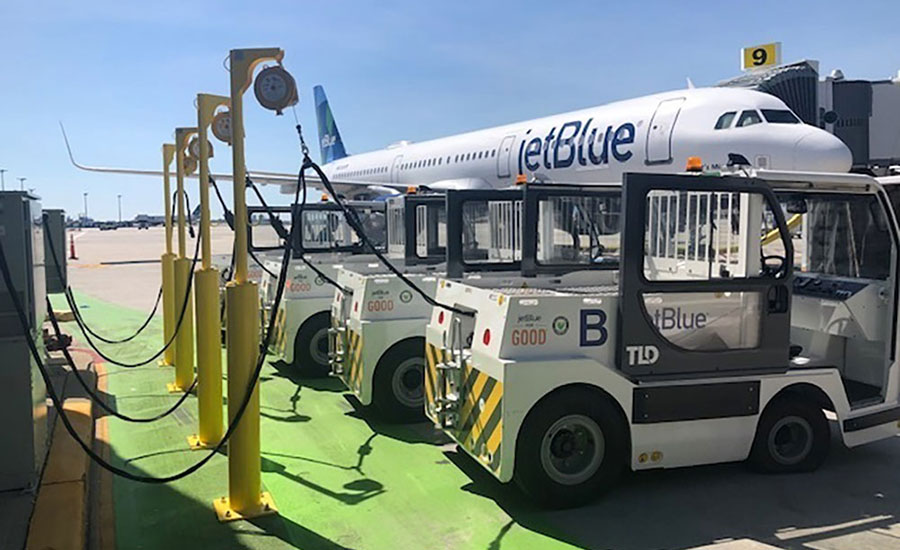
Electric ground support equipment helps airports and airlines reduce noise and improve energy efficiency. Photo courtesy JetBlue
Riding a New Wave of GSEs
Waev Inc., an electric vehicle company, was founded in 2021 to support the Tiger brand of GSEs and recently launched Tiger lithium-ion tow tractors and Tiger Repower conversion kits. Tiger heavy-duty tow tractors have been moving baggage and cargo around airports since 1981.
"There are several core components to the vehicle—a steel frame, mechanical elements such steering gear, and the rear differential that negotiates the speed, and then the power train," says Alfredo Romero, chief operating officer of Waev. "[Besides a gas version], we offer an electric power train that consist of a lithium-ion phosphate cluster of 120-volt battery cells with a motor module built into it."
The vehicle is designed so that the chassis and steering components can be used for both the ICE and EV versions. The rear differential and front steering axles are attached at Waev’s assembly plant in Anaheim, CA.
"There are six general stations where we have between two and three operators per station equipped with air power tools,” explains Romero. “Each station has a quality check back procedure, where the subsequent station is responsible for checking the previous station's work.
"Our schedule is very in sync with our supply chain, so we know what power modules are getting brought in and we know what we're building," says Romero. "We coordinate with our suppliers on what our build schedule is. We can easily build three gas power trains followed by two electric power trains."
The electric version of the Tiger tractor comes equipped with anti-roll technology, a motor controller with software programmed on top of it to regulate the speed based on the vehicle's turning. Electronic safety features like this help reduce the risk of a vehicle rollover, which in the past has led to serious injuries at some airports.
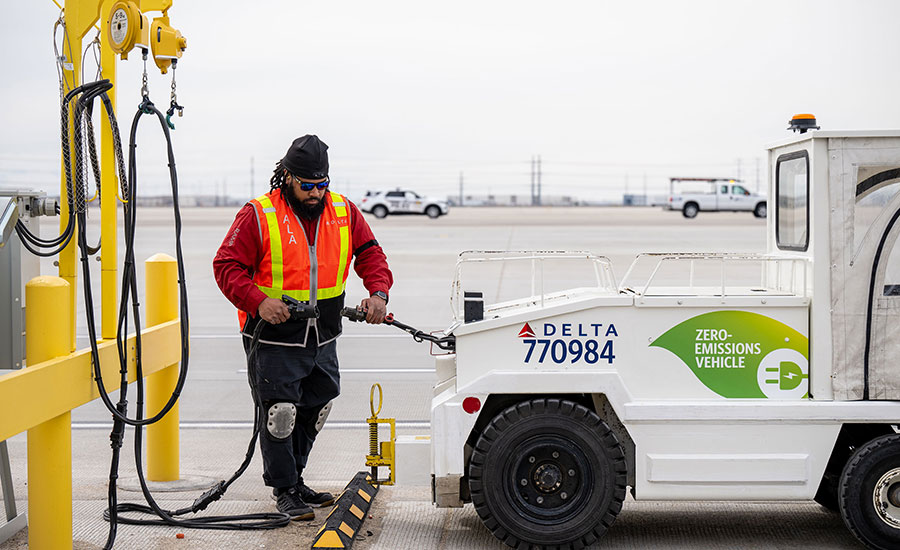
Lack of recharging infrastructure is a challenge at many airports. Photo courtesy Delta Air Lines
"There's a gyroscope inside the motor controller that understands how the vehicle is turning and the speed at which it's turning, so it will automatically decelerate if it senses the speed is too fast," Romero points out.
An additional benefit of going electric is drastically reduced maintenance requirements due to the low number of mechanical elements. That’s important, because breakdowns can hamper airport operations, affecting both arrivals and departures.
"With a traditional gas tractor, you have engine parts that break down, pistons, cylinders, actuators,” says Romero. “All these mechanical elements experience heavy abuse. They're outside; they get snowed on, rained on and [exposed to searing] heat."
"Even if one cell fails inside an EV power module, the module is resistant enough and there's enough redundancy to keep the vehicle operating," claims Romero. “Lithium-ion phosphate batteries ensure safety and utility. It's a nonvolatile lithium that is not susceptible to...extreme heat or extreme cold.”
Building Better Batteries
Flux Power specializes in lithium-ion batteries for various types of material handling applications, including belt loaders, forklifts and scissor lifts.
"We have a modular system of battery packs [similar to] Legos," says Ron Dutt, CEO of Flux Power. "Belt loaders require just an 80-volt, 210-amp pack, which is one module. Baggage trucks may require two of those put together in parallel to give you 420 amps. A pushback tractor would require bigger bursts of energy, but only for short periods of time.
Flux Power’s battery management system was designed and developed in-house for GSE applications. Software ensures the battery always provides peak performance when in operation—even at low charge levels—delivers longer run times between charges and maximizes the overall battery lifespan. The packs, which can be integrated with multiple equipment manufacturers and offer customized sizes to fit most units, are produced at a 60,000-square-foot factory in Vista, CA.
"We don't fabricate any steel or assemble printed circuit boards (PCBs) and electronic components," says Dutt. "We design, develop and test everything, but we outsource PCBs according to our proprietary designs for the boards.
“We have eight assembly lines for the different sized packs," explains Dutt. "Once they're assembled, we cycle the packs through a charge and discharge cycle, then monitor the state of current and voltage performance of the packs.”
Airports and airlines face several challenges when it comes to electrifying their GSE fleets. One is vehicle reliability at low temperatures. That’s not a big problem in Miami, but it can lead to huge headaches and snarl airline traffic in Chicago.
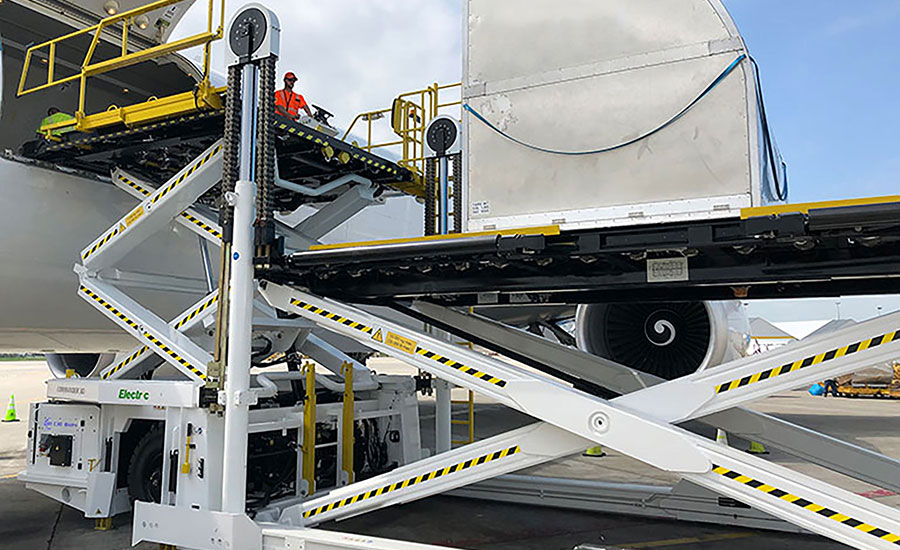
This electric cargo loader can handle up to 33,000-pound payloads. Photo courtesy JBT AeroTech
"Especially for deicing and snow removal vehicles, that is a concern,” warns Avports’ Garcia. “However, it is getting much better now, and we have more equipment that is able to operate in lower temperatures.”
But, when there is a snowstorm, it's not easy to estimate how long those vehicles may need to be in operation. That creates range anxiety, albeit one determined by length of use instead of travel distance.
"We need to have the vehicles ready all the time,” says Garcia. “There is no time for those vehicles to sit charging for a while, because if snow is falling heavily, we need to keep it off the runways or else we have to close the airport."
The combination of performance in lower temperature and the ability to keep those vehicles in operation or ready to operate as long as possible are areas where Garcia sees room for improvement.
To account for environmental challenges and weather conditions, Flux Power tests its battery packs in Minneapolis in the winter and Phoenix in the summer to ensure they can handle extreme temperatures.
"We have a heating band that keeps the batteries warm in Minneapolis,” says Dutt. “You don't want to charge lithium batteries below 32 F, otherwise it starts to degrade the life of the battery. We add heating elements that are controlled by the firmware and circuit boards."
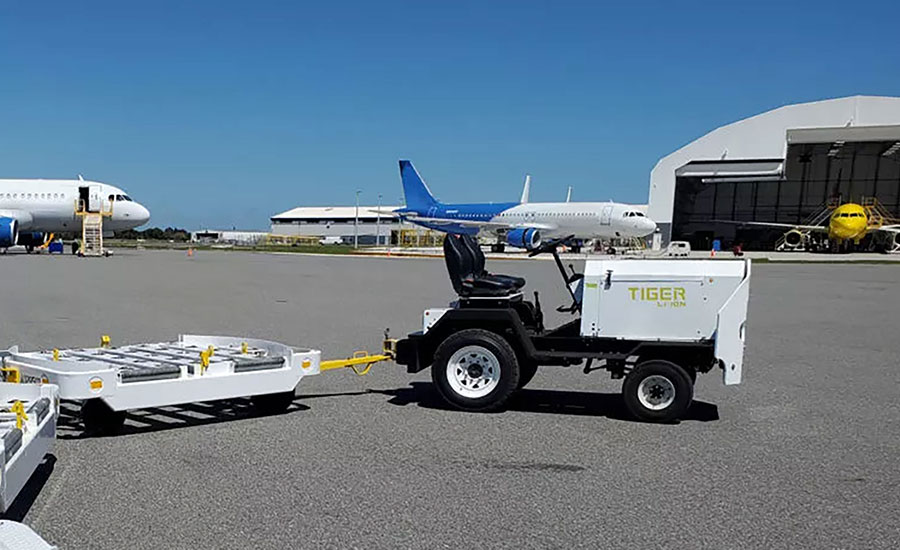
Battery-powered tow tractors are moving baggage and cargo around more and more airports. Photo courtesy Waev Inc.
Hydrogen Potential
The aviation industry is experiencing a shift toward incorporating hydrogen as a power source for GSEs. For instance, JBT AeroTech recently partnered with Universal Hydrogen Co. to develop a fuel cell-powered mobile battery charger called the H2AmpCart for existing electrified airport GSEs.
While the technology offers quick refueling compared to traditional electric charging, there are initial cost considerations associated with implementing hydrogen fuel cells. Infrastructure development poses a significant hurdle, requiring airports to invest in hydrogen production, storage and distribution facilities.
To address the issue, RevoZero Corp. is in the process of building a nationwide hydrogen network to provide quick and economical fast-refueling. Its hydrogen-as-a-service (HaaS) system is designed to enable airports to use hydrogen as a fuel without investing in production or storage infrastructure.
"We deploy the equipment at no cost to the airport, which pays for the hydrogen under a pay-as-you-go model for ground operations vehicles," says Ruben Creus, CEO of RevoZero. “We are looking for these closed-environment fleets where we could deploy a hydrogen system and a lot of vehicles can use it."
According to Creus, hydrogen offers significant advantages over battery-powered technology because of higher energy density and the speed of refueling. Hydrogen-powered vehicles can refuel in a matter of minutes, and hydrogen fuel cells can offer an extended range compared to some battery technologies, making them suitable for applications where long periods between refueling is critical.
"We believe that batteries are great for very specific applications, but for real professional equipment, you cannot afford to be using a GSE for two hours and then charging it for 10 hours," notes Creus.
Most GSE manufacturers are developing electric models or offer retrofit possibilities.
"It's a matter of survival, because everybody knows it's a must," says Garcia. "No manufacturer is going to survive if they don't have good options for different use cases and different vehicles.
"We've seen movement from manufacturers that are focusing on retrofitting existing vehicles into zero emission vehicles,” Garcia points out. He believes this helps accelerate the transition, because companies recognize that the lifecycle of the vehicle is not over. There is an option to use the same platform by simply swapping the power plant.
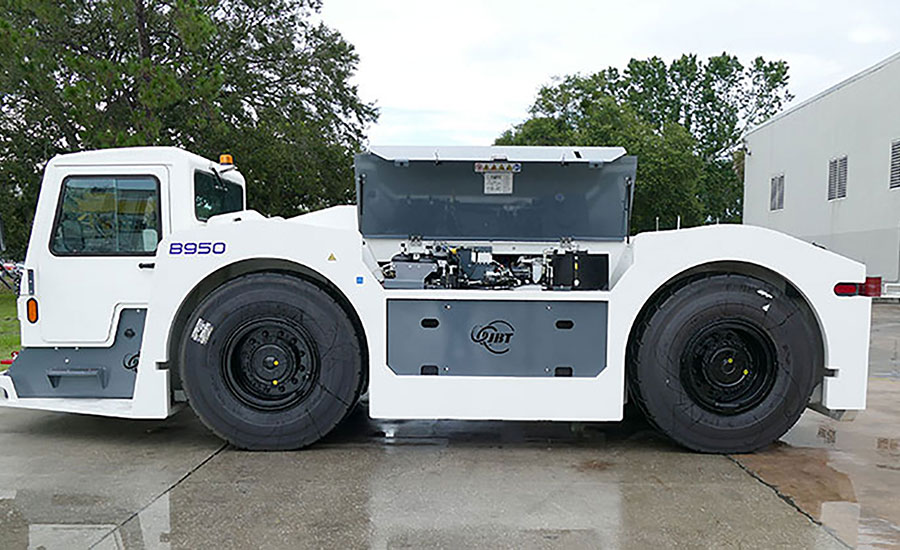
Electric pushback tractors and tugs can help the aviation industry reduce greenhouse gas emissions. Photo courtesy JBT AeroTech
Harlan, for instance, offers an electrification kit suited for installation in competing vehicles and its own older models. The kit includes a 460-amp, 80-volt lithium-ion battery pack with a battery management system, relays, electronic controls and steering devices included.
"It's plug and play,” says Kaplan. “You have a computer screen that gives you all the data you need on the dashboard, and we offer different levels of kits. You can get a standalone motor that you can bolt in and use your existing drive axle, or you can take out your existing drive axle and put in an electric drive axle."
Last year, Waev debuted the Tiger Repower conversion kit. It’s designed to streamline the transition to electric tow tractors. The comprehensive kit includes a power module, rear axle, motor, dashboard, LED lights, braking system, accelerator pedal and a wiring harness.
"The kit is available to a much broader market, not people who have initially purchased the gas-powered Tiger," says Romero.
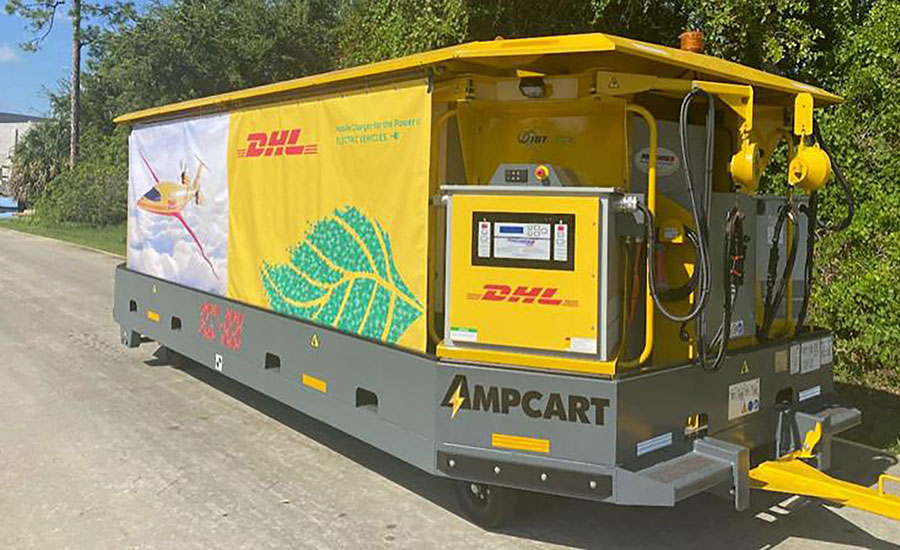
This mobile charging platform is designed for battery-powered ground support equipment. Photo courtesy DHL Group
Infrastructure Challenges
One of the biggest challenges facing airports and the GSE electrification evolution is the lack of charging infrastructure and power supply issues.
"The availability of power from the grid for the growing demand that we have, with higher number of vehicles charging at the same time, is definitely a challenge,” says Garcia. “That's something we are analyzing and working with utility companies to [address.].”
"[The relatively small footprint of most airports] helps us to better plan those charging points and centralize the places where it would be most efficient to build and to manage that power," explains Garcia. "If you compare that with a network of transportation vehicles where distances are much higher, it makes it more difficult to manage."
"Charging infrastructure is definitely one area of improvement that we see coming in the near future,” adds JBT AeroTech’s Ghugari. “But, it's still slow today. If the charging infrastructure improves rapidly, then we'll see a lot faster transition to electric GSE."
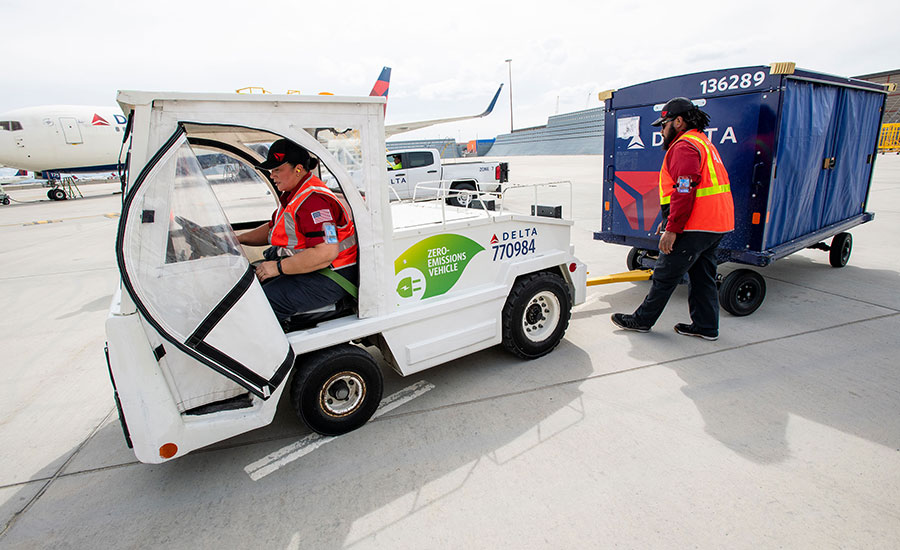
Whether large or small, all airports require a diverse array of vehicles to keep operations running smoothly. Photo courtesy Delta Air Lines
To offset the lack of charging capabilities, mobile amp carts like the one developed by JBT AeroTech can be easily moved around airports. They’re intended for remote charging operations when a vehicle or aircraft is far away from a gate, such as air cargo operations.
Most experts believe airport ground support equipment will become more autonomous in the future. That development will help address labor shortages and safety issues.
Automated baggage loaders, self-driving tugs and robotic maintenance units have the potential to further revolutionize the way airports handle ground operations, promising a future where intelligent machines collaborate seamlessly with human operators. As the technology advances, autonomous GSE features are also becoming more prevalent, offering the promise of increased precision, efficiency and safety.
"By building in greater autonomy, we have the potential to increase safety, increase performance, increase efficiency and reduce operating costs," says Garcia. "That's an area we are very interested in and where we have already experimented."
As it becomes a larger area of focus, Avport plans to continue research on the topic and work with the Transportation Research Bureau to further develop opportunities for augmenting the autonomous GSE capabilities.
Learn about new products for autonomous and electric mobility
Zimmer Group – development partner for battery production
CTC Series High Performance Bell-type Suction Cups for Automotive
Articulating Roller Forming Machine with 3-Axis Servo Technology
High Speed Rotary Indexing Devices for Battery Manufacturing
Go Smarter. Go Boldly.

